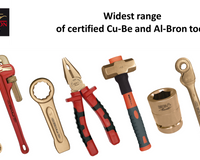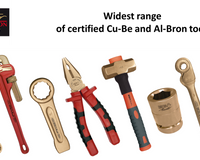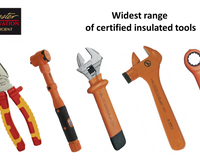According to the Directive 1999/92/EC, steel tools are considered a source of ignition and therefore not safe to be used in the presence of an explosive atmosphere. In such environments, it is mandatory to use non-sparking tools.
However, based on our experience in the global industrial sector, there are still many procurement, maintenance and even safety professionals who are still not fully familiar with what non-sparking tools are and what are the key criteria to use when procuring or using such tools.
The most common non-sparking alloys are Aluminum - Bronce (Al-Bron) and Copper – Beryllium (Cu-Be), but what should be the criteria when choosing one option or the other?
The type of gas in the environment
Despite its name, non-sparking tools do generate a spark (friction between all metals generate a spark). The difference between non-sparking tools and normal steel tools is the energy of the spark they generate.
They key objective to avoid an explosion is therefore for the energy of the sparks to be lower than the ignition point of the gas in the atmosphere.
In order to make sure that the right non-sparking tool is used, the first step is therefore to understand what kind of gas will be present in the atmosphere.
Gases are classified into four main groups as seen in the following table. The gases in group IIC are the most dangerous ones since they have the lowest ignition point.

Sparks generated by the Cu-Be non-sparking tools are the ones with the lowest energy level, and as a result, are the safest ones to be used across all gas groups (I, IIA, IIB and IIC).
The only exception is in the presence of Acetylene, in which case, both Al-Bron and Cu-Be tools would not safe due to the high amount of copper in their composition (copper reacts with the Acetylene gas to form highly explosive particles called acetylides). For safe operations in the presence of Acetylene gas, EGA Master has developed a proprietary alloy called ACETILEX®, which has less than 65% of copper in its composition.
Frequency of use
Even if Cu-Be non-sparking tools are the safest option, their purchase price is higher than that of Al-Bron tools. In the presence of group IIC gases there is no safe alternative to Cu-Be tools, however, Al-Bron tools could be a viable alternative when working in the presence of gases in groups I, IIA or IIB.
The key factor to be considered in such cases is the frequency of use of the non-sparking tools, mainly since Al-Bron tools are softer and therefore break easier (see table below).

If you use non-sparking tools frequently, Al-Bron tools may actually represent a more expensive option over time considering the replacement costs over time.
Certification
As with all safety critical products, trust is key.
If the energy of the spark generated by the non-sparking tools depends on the material composition of the tool, any variation of the material composition would have a direct impact on the energy levels of the spark generated.
In order to be 100% confident that the tool purchased and used will no generate a spark that will reach the ignition temperature of the gas, it is recommended that procurement managers request manufacturers to provide a third party certification of the material properties of the tools against the requirements of the Directive 1999/92/EC.
Such a certificate is not related to the management systems of a company (e.g. ISO 9001 or ISO 18000) or to the mechanical properties of the tool (e.g. against DIN standards). A certification of the material properties focuses on the material composition of the tools, to ensure that the energy levels of the sparks generated are those that are considered safe to be used in the presence of the different gas groups.
Like with any certification, it is recommended that such a test is carried out by an independent third party (to avoid any conflicts of interests). The German Federal Institute for Materials Research and Testing (BAM) is one of the best-known laboratories approved by the European Union to certify according to the Directive 1999/92/EC.
Marking of the alloy on every tool
Al-Bron and Cu-Be tools have similar colors and are therefore difficult to differentiate. Considering that choosing the right alloy is such a critical step to ensure safety, it is highly important that those procuring and using the products are 100% sure that they chose the right one.
The only way to achieve that is by having the allow laser marked on every non-sparking tool. This is the only way to ensure that the manufacturer has delivered the right alloy, and that the field teams take the right tools when starting their shifts.
EGA Master offers the widest range of BAM certified Al-Bron and Cu-Be non-sparking tools. EGA Master also marks the alloy on 100% of its non-sparking tools! Check the range here!
Did you find this blog useful? You may also find these other posts interesting:
Non-sparking tools: Learn the basic concepts and be safe!




